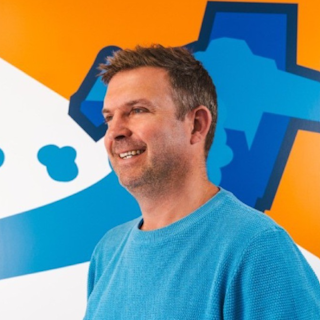We must burn bridges with big social or meet our end
Kwalee’s Harry Lang asserts we must block off destructive behaviors caused by social media if we want to protect young people from getting hurt.

/ Canva
‘Never burn your bridges’ is the advice I regularly received during my early career in agencies. It seemed like good counsel at the time, too. But it had an expiry date. I now know that if you’re going to burn any bridges, then River Kwai, that bad boy - just to be certain there’s no going back.
Back then, I had only burnt one bridge. It was with a client, not qualified to manipulate Play-Doh let alone multiple drinks brands. I emailed him on my final day in an agency role, pointing out his (many and varied) flaws. I knew if I ever had the misfortune to work with him again, my career was already over, and I’d have to find a welcoming monastery to see out my days instead.
He never replied (he probably couldn’t work out how to send an email), but that didn’t matter. I felt no better – in fact, I felt a little sordid. I’d been paid to do a job that included managing tough clients, and by sending that one single email, I’d fallen at the last fence. I wandered home that night feeling hollow and felt very much like I’d let myself - and the agency - down.
But it took me many years to realize that bridge burning was sometimes appropriate - even essential - if due thought, consideration, and, crucially, time is committed to the decision.
The second bridge to burn
For seventeen years, I honed my skills to enable various online poker, casino, sports betting, bingo and esports betting brands to extrapolate the maximum revenue from punters worldwide. It’s a good business, regulated gambling. Punters (the customers) rarely win. And the House (you) mostly does. But I can guarantee it’s unequivocally fair in the way the money is taken off you.
As a career, I wasn’t particularly proud of what I did for a living, and at times I was actively sad about it.
It is ethical? Debatable.
Is it legal? The regulated operators are, yes.
Is it a net contributor to the betterment of humankind? No.
If you gamble online (don’t - it’s a mug’s game), then good for you - it just wasn’t good for me, and I never, ever, ever want to work in the sector again, which is why I’m happy to publicly and openly nuke that particular bridge from orbit - just to be sure.
I’ve waited two and a half years to get that off my chest, and now that bridge is well and truly toasted, I won’t be welcomed back into the gambling industry for a couple of generations at least.
Excellent.
And now a third bridge
Listening to Radio 4 on my way to work recently, I heard an extremely eloquent interview with Tristan Harris, co-founder of the Center for Humane Technology and former design ethicist at Google. Tristan spoke of AI, social media and how the big platforms were in a ‘...race to the bottom of the brain stem’. He was talking about beautification tools and how apps like Insta and TikTok can artificially enhance user pictures to make them look more physically attractive.
He even suggested TikTok automatically makes users ‘5% better looking’ through unrequested enhancement, and yes, this ‘Mirror, Mirror’ strategy does make people want to use the app above others, and the tactic is exactly as nefarious and dangerous as it sounds.
The exponential increase in anxiety, depression, body dysmorphic disorder, drug abuse and self-harm among young people around the world (especially young women) can be neatly mapped over the increase in global social media use over the past 15 years.
Social media is, at the very least partially, to blame - and yet Facebook, Instagram, TikTok, Google, Discord, Snap, and Twitter (I’m not saying X) seemingly don’t give a shit about anything apart from their market cap as anyone who saw Zuckerberg’s testimony in January’s congressional hearing about alleged online harms to children caused by his social platforms would attest…
Access to illegal drugs, exacerbating body dysmorphia, magnifying and normalizing racial hate speech, buying and selling children for sex… it’s like Satan set up an online shop, and everyone willingly let him promote the very worst human behaviors.
Summarising the efficacy of the hearing and the response of the big social CEOs that testified, senator Lindsey Graham said: “The bottom line, I’ve come to conclude, is that you aren’t going to support any of this... if you’re waiting on these guys to solve the problem, we’re going to die waiting”.
This is where bridge burning has a place. We’re clearly riding a train to hell as a society, and the social media firms not only stoked the fires, they gave everyone their own free, personalized carriage. If big social ever had a fragment of integrity, they would’ve sold it for clicks long ago - so it’s up to people and governments to clear up this stinking mess.
I’m the father of a wonderful young girl, and I’m honestly more terrified of her navigation through her mobile-enabled, image-enhanced, socially damaging, poisonously intoxicating teenage years than my own death. But it’s not just girls who are suffering - teenage boys, fuelled by Huel (and motivated by six-packed Adonises with bodies only achievable through steroids and Photoshop), are being beaten into submission by unattainable fantasies and an ever-decreasing supply of self-confidence until they’ll shadows of their former selves.
While depressed and misled in this low and impressionable ebb, they’re easy prey for the witless bullshit of misogynistic fartboxes like Andrew Tate - a man so bereft of class, self-awareness or redeemable features he should genuinely be jailed for stealing oxygen (if he weren’t already jailed).
It’s a digital minefield - one in which young people are actually dying - and unless people and governments get their act together and cut ties with this irresponsible past, then more bodies will be unnecessarily discarded.
The issue is inherently around trust. Governments trust big social to operate ethically - they can’t. People trust what they see on social media - they shouldn’t. But they often do. Be it an AI-generated ad for a Willy Wonka experience, allegedly state-backed speculation about the disappearance of a princess, or misinformation about bridges, cyberwar and World War 3.
Voters don’t trust the government to look out for their best interests online - and they’re right.
We’ve clearly gone backwards as a society, and it’s time voters pushed governments to burn the bridges to this embarrassing past, starting with some functional constraints on the power and influence of big social so they are forced to point technology in the direction of a less destitute and more hopeful future.
While there’s still cash to be made, Apple, Google, Meta, TikTok, and Twitter certainly won’t do anything to help on their own.
Harry Lang is VP of Marketing at game developer and publisher Kwalee and author of ‘Brands, Bandwagons & Bullshit’ - a 5 Star rated book about how marketing works, available on Amazon. You can find Harry at @MrHarryLang and connect with him on LinkedIn.

